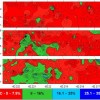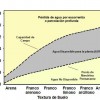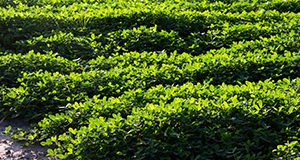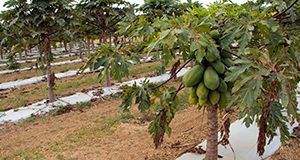Effective irrigation scheduling enables the irrigator to apply the right amount of water at the right time to meet the crop water demand. This 19-page guide presents information on average daily and weekly crop water use and crop growth stages for twelve north Florida crops that can be used to help schedule irrigation. This will allow a grower to develop a realistic irrigation schedule that minimizes plant water stress, saves water, and reduces nutrient leaching potential. Written by Vivek Sharma, Charles Barrett, De Broughton, and Thomas Obreza, and published by the UF/IFAS Department of Soil and Water Sciences, revised December 2020.
https://edis.ifas.ufl.edu/ss491
Tag: Irrigation Scheduling
ET-Based Irrigation Scheduling for Papaya (Carica papaya) in Florida
Three irrigation scheduling methods (set schedule, ET-based, and tensiometer-based) were tested for papaya production in south Florida. ET-based irrigation scheduling was found to conserve water effectively. This 6-page document primarily focuses on the ET-based irrigation scheduling techniques for papaya under Florida conditions. Written by Haimanote K. Bayabil, Jonathan H. Crane, Kati W. Migliaccio, Yuncong Li, and Fredy Ballen, and published by the UF/IFAS Department of Agricultural and Biological Engineering, March 2020.
https://edis.ifas.ufl.edu/ae540
Minimum Number of Soil Moisture Sensors for Monitoring and Irrigation Purposes
 Managing soil moisture properly through irrigation is key to increasing crop yield and conserving water. By understanding soil moisture variability, growers can better manage their irrigation systems to apply the right amount of water at the right time. This 4-page fact sheet proposes guidelines for soil moisture sampling that account for spatial variability, which helps to determine the minimum number of soil moisture sensors required to survey and monitor a specific area for irrigation. Written by Lincoln Zotarelli, Michael D. Dukes, and Marcelo Paranhos, and published by the UF Department of Horticultural Sciences, July 2013.
Managing soil moisture properly through irrigation is key to increasing crop yield and conserving water. By understanding soil moisture variability, growers can better manage their irrigation systems to apply the right amount of water at the right time. This 4-page fact sheet proposes guidelines for soil moisture sampling that account for spatial variability, which helps to determine the minimum number of soil moisture sensors required to survey and monitor a specific area for irrigation. Written by Lincoln Zotarelli, Michael D. Dukes, and Marcelo Paranhos, and published by the UF Department of Horticultural Sciences, July 2013.
http://edis.ifas.ufl.edu/hs1222
Interpretacion del contenido de la humedad del suelo para determinar capacidad de campo y evitar riego excesivo en suelos arenosos utilizando sensores de humedad (AE496)
 Este documento resume las directrices para la determinación de la capacidad de campo y la programación óptima del riego para suelos arenosos utilizando sensores de medición de la humedad del suelo (SHS). Los sensores de humedad del suelo han demostrado potencial para el monitoreo de la humedad del suelo, y para el respaldo en la toma de decisiones de riego en cultivos hortícolas. This 4-page fact sheet was written by Lincoln Zotarelli, Michael D. Dukes, y Kelly T. Morgan, and published by the UF Department of Agricultural and Biological Engineering, January 2013.
Este documento resume las directrices para la determinación de la capacidad de campo y la programación óptima del riego para suelos arenosos utilizando sensores de medición de la humedad del suelo (SHS). Los sensores de humedad del suelo han demostrado potencial para el monitoreo de la humedad del suelo, y para el respaldo en la toma de decisiones de riego en cultivos hortícolas. This 4-page fact sheet was written by Lincoln Zotarelli, Michael D. Dukes, y Kelly T. Morgan, and published by the UF Department of Agricultural and Biological Engineering, January 2013.
http://edis.ifas.ufl.edu/ae496
SL296/SS509 Citrus Cold Weather Protection and Irrigation Scheduling Tools Using Florida Automated Weather Network (FAWN) Data
SL-296, an 8-page illustrated fact sheet by John L. Jackson, Kelly Morgan and William R. Lusher, provides an overview of the water saving tools that are available to citrus growers on the FAWN Web site — the Cold Protection Toolkit and the citrus microsprinkler irrigation scheduler. Published by the UF Department of Soil and Water Sciences, September 2009.
http://edis.ifas.ufl.edu/SS509
SL285/SS499 A Web-Based Irrigation Scheduling Model to Improve Water Use Efficiency and Reduce Nutrient Leaching for Florida Citrus
SL285, a 4-page illustrated fact sheet by Kelly T. Morgan, Edward A. Hanlon, and Thomas A. Obreza, describes an easy to use web-based water-balance irrigation scheduling tool that assists growers in determining irrigation schedules that can improve water use efficiency and reduce nutrient leaching. Published by the UF Department of Soil and Water Science, May 2009.
http://edis.ifas.ufl.edu/SS499
TR001 Irrigation Scheduling for Tropical Fruit Groves in South Florida
TR001, a 6-page illustrated fact sheet by Kati W. Migliaccio and Yuncong Li, describes why irrigation is needed in south Florida, and the advantages and disadvantages of various tools available for determining an optimum irrigation schedule. Includes references. Published by the UF Department of Agricultural and Biological Engineering, January 2009.
http://edis.ifas.ufl.edu/TR001
SL278/SS491 Crop Water Use and Irrigation Scheduling Guide for North Florida
SL-278, an 18-page illustrated guide by Thomas Obreza, presents average daily water use for 13 North Florida crops that can be used to help schedule irrigation. Published by the UF Department of Soil and Water Science, December 2008.
http://edis.ifas.ufl.edu/SS491

